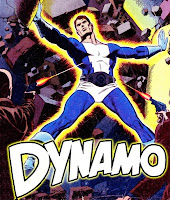T.H.U.N.D.E.R. Agents Classics Vol. 1 (2013)
IDW Publishing
Trade paperback, 235 pages
ISBN 9781613776896
Retail $29.99
Although it was published around the same time I was reading comics as a kid, I’d never read T.H.U.N.D.E.R. Agents until last week. Maybe the reason it wasn’t on my radar was because it wasn’t a Marvel or DC title. It was published by Tower Comics, a company that published 64-page comics at 25¢ an issue, while most of the other publishers were sticking to 32-page comics at 12¢ an issue.
Tower didn’t last long, starting in 1965 and going defunct four years later. But they did manage to snag the extraordinary Wally Wood to draw T.H.U.N.D.E.R. Agents. I don’t know much about the history of Tower or of T.H.U.N.D.E.R. Agents, but I imagine that 64 pages (even bi-monthly) was too much for Wood. That idea is further evidenced by the appearance of several other artists in this volume (which covers T.H.U.N.D.E.R. Agents #1-4), including Reed Crandall, Gil Kane, George Tuska, Mike Esposito, Dan Adkins, Dick Ayers, Joe Orlando, and a whole plethora of others.
Writing assignments are also all over the place. The first story is penned by Larry Ivie, followed by other writers, mostly Len Brown, Bill Pearson, Steve Skeates. A great number of the stories here are simply credited as “unknown.”
In a way, this works to the comic’s strength, since the characters/teams of T.H.U.N.D.E.R. Agents rarely work together. Instead, each character is initially given his own complete story within each book, starting with Dynamo, an ordinary man named Leonard Brown who wears a Thunder belt, giving him incredible strength and making him invincible for short periods of time. Then there’s NoMan, an aging scientist who transfers his mind into the body of an android. (NoMan also has an invisibility cloak.) And perhaps the most interesting character, John Janus, who becomes Menthor when he puts on a special helmet, giving him extraordinary mental powers (including mind control). But Janus is actually a double-agent, working for the evil Warlord. There’s also a T.H.U.N.D.E.R. Squad, a team of superagents tracking the location and activities of the Warlord.
Of course with names like those, you know the stories are likely to be goofy and/or hokey. Yet you might be surprised....
T.H.U.N.D.E.R. Agents clearly jumps on the spy/espionage bandwagon, following the lead of the James Bond 007 movies (only four had been released by this time) and the hit TV show The Man from U.N.C.L.E. It doesn’t take long until you realize T.H.U.N.D.E.R. Agents isn’t sure whether it wants to be a spy comic or a superhero comic, so it does both. It doesn’t always work, but it’s surprising that it works so often, especially considering all the hands that were involved in creating it.
Part of the appeal of T.H.U.N.D.E.R. Agents (besides Wally Wood) is stepping back in time to an era when espionage was fun, dangerous, and silly. The comic goes back and forth between taking itself seriously and poking fun at itself, sometimes in successive panels. Here’s one such exchange when the evil Iron Maiden tries to seduce Dynamo into joining her:
Iron Maiden: “Don’t be insolent. Team up with me and we could rule the Earth:”
Dynamo: “Sorry. I’d rather not rule the Earth. I just want to marry the girl next door and live in the suburbs.”
T.H.U.N.D.E.R. Agents is a great example of Silver Age fun, something I’m sorry I missed out on the first time, but am glad to have a chance to experience it now, thanks to IDW. T.H.U.N.D.E.R. Agents has had other incarnations including the current new series, but personally, I’m looking forward to the next volume of the classic series.
4/5






No comments:
Post a Comment